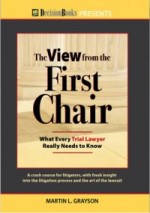In this excerpt from his book The View from the First Chair, veteran California defense lawyer Martin L. Grayson offers a crash course on the importance of courthouse demeanor, with tips for always (always) presenting your best professional image. Martin is also featured in LawyerAvenue Press’s new “How to Litigate” video series—and you can watch his “Courthouse Demeanor” video below.
Imagine you’re at a neighborhood party, having drinks with some friends. In walks Buddy, a neighbor who borrowed your ladder earlier in the day but forgot to return it. Buddy sees you across the room, waves, and shakes his head as if in apology for his lapse of memory. You nod and smile amiably, and turn back to your friends who, at that very moment, are laughing at a shared joke. It’s very possible Buddy will assume the laughter is at his expense. It’s only human nature.
In a roundabout way, this illustrates why you should never smile in the courtroom. Because those present—the jurors on your case, the bailiffs, the clerks, the court reporters—will not know why you are smiling and may assume the worst. They may assume—because it’s only human nature—that it has something to do with the case that now occupies their attention. They just might think your smile is about them.
Never Underestimate the Power of Courthouse Demeanor
Your demeanor should be intended to persuade the judge, jury, bailiff, clerks, parties, witnesses, and anyone else who might be passing through, that you are a serious person, an honest person, a dignified person, an organized person and—for the purposes of the case at bar—the person with the correct view of reality. This image would be difficult to maintain if a juror walking through the parking lot saw you throwing off your suit and pulling on a pair of baggy shorts and a ripped T-shirt while chugging a 40-ounce adult beverage. So remember, anywhere in the courthouse where you might possibly be seen or heard litigating, negotiating or consulting—through an office window, down the hall, in a restroom—you must always be on guard to present a professional image. Pretty much, that means anywhere in public.
Here are a few more tips for courthouse behavior.
Stay on the Judge’s Good Side
One of the biggest mistakes an attorney can make is to alienate the judge. You will put yourself and your client at risk of losing every close call, having every request for continuance or extension of discovery procedures summarily denied and, worst of all, having the judge signal the jury at trial that you are not trustworthy. Even if the judge sprays your new suit with purple acid from a hose he keeps on the bench, you say, “Thank you, Your Honor.” Your only chance of keeping the jury even partially on your side is to refrain from telling the judge how you will regret to your dying day the $10 you contributed to his last campaign. You may feel better afterward, but always bear in mind that your client will be picking up the tab for your moment of joy.
In the courtroom, be as polite, obsequious and humble as your nature will permit … certainly more than your nature might deem dignified. Fawning is not unacceptable, and bowing and scraping is not to be overlooked. No judge has ever admonished a lawyer for being too respectful.
Ingratiate Yourself with the Courthouse Staff
It is common sense to assume that your interactions with courthouse staff will find their way to the judge. Thus, in addition to keeping a polite, low-key, professionally calm demeanor in and around the courthouse, you must also ingratiate yourself with the staff. Believe me, it has its benefits. If, on occasion, you make a comment that elicits a laugh from another attorney, the clerk is more likely to take it in stride. And if the judge asks, “What was that laughter in the courtroom?” the clerk—your buddy—might be more inclined to say, “Oh, that was Mr. Grayson. He’s such a friendly and gracious person. I think he said something to cheer someone up and they were laughing a little,” instead of, “It was Grayson, Judge. What a jerk. He’s here again today on GenMar. Number 6 on the docket. I don’t know why you just don’t find him in contempt and get him disbarred. Jail time would do him a lot of good.”
Remember Courthouse Demeanor Also Extends to Telephone Calls
One day an attorney on a court call, who assumed his phone was on mute, could be overheard babbling to a buddy, then to an assistant, all while the judge was trying to conduct other business. Thinking this counsel was talking to the court, she twice advised him to remain “on hold” until his docket number was called. To no avail! Finally, the judge told him that everything he said was being broadcast into the courtroom and ordered him to stand by, silently, until he was recognized. Counsel apologized—and then we all heard him press the mute button, and launch into yet another round of office babble. He had no idea his mute button had malfunctioned.
Here’s Grayson’s Rule: If you’re on the phone to the court during a court call, or for any other business, assume you are actually in court and not simply in your office talking to the judge or clerk on a speakerphone. If this particular counsel had understood, he might have sat quietly at his desk, shuffling papers, reading the newspaper—even getting his shoes shined—but he would not have been making a fool of himself. The psychology of human perception and the inferences drawn from them loom large in law and business. You have a lot to lose and absolutely nothing to gain from ignoring that fact.
Most Judges Hate to Judge
In my experience, most judges want you to settle your case, dismiss your suit, take the plea bargain, pay the demand. Judges do not want to actually decide anything if they can avoid it. You can use the judge’s own motives to your benefit and get the result you seek. How? By couching every argument in terms that fulfill and support the judge’s most secret and fervent desire: To watch you dissolve into molecular space dust before the lunch break. Every utterance and every suggestion must appear to be aimed not at winning points for your team, but at helping the court resolve the dispute as quickly and painlessly as possible. Sprinkle your comments with introductions such as, “In order to move this matter along as quickly as possible, perhaps ….” Or, “To give us the best chance to reach early resolution ….” While your opponents flail around, arguing arcane points of law and procedure, they will find themselves sinking in quicksand as you calmly and casually lead the judge to agreeing with your every suggestion.
This is not to say you can be unprepared on the law and the facts and flim-flam the court with obsequious comments. I’m simply suggesting you must carefully craft your arguments. That ticking sound you hear will be the judge’s heart going pitter-patter, pitter-patter.
Watch the Video
Martin Grayson is featured in LawyerAvenue Press’s new “How to Litigate” video series. Watch his “Courthouse Demeanor” video below.
Martin L. Grayson is a California defense lawyer and author of The View from the First Chair (Lawyer Avenue Press), a crash course that offers fresh insight into the litigation process and the art of the lawsuit. A former journalist, Martin is a former member of the board of editors for the ABA Litigation Section magazine, Litigation, a former Judge Pro Tempore for Los Angeles County Superior Court and, in 25 years, has litigated hundreds of maritime, oil and gas, transportation, insurance, and corporate cases. He blogs at www.GraysonOnTrials.com.






















